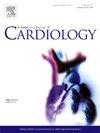中高低温循环停搏对急性A型主动脉夹层术后主要不良事件的影响。
IF 3.2
2区 医学
Q2 CARDIAC & CARDIOVASCULAR SYSTEMS
引用次数: 0
摘要
目的:比较高-中度低温循环停搏(HMHCA)与低-中度和深度低温循环停搏(LDHCA)对急性A型主动脉夹层(ATAAD)患者主动脉修复术后主要不良事件(MAEs)的影响。方法:2013年1月至2021年12月,共有555名患者采用HMHCA策略接受主动脉修复手术,262名患者采用LDHCA策略。通过HMHCA组和LDHCA组的比较,评估不同HCA温度对术后MAEs的影响。结果:平均年龄是48.6 ±10.8 HMHCA组和47.2±10.4 LDHCA组(P = 0.086),与类似的女性性别分布(22.3 vs 24.4 % % P = 0.533)。HMHCA组术前脑灌注不良综合征发生率低于LDHCA组(7.0 % vs 11.0 %,P = 0.058)。两组体外循环持续时间具有可比性;然而,HMHCA组患者表现出主动脉交叉夹持持续时间更长,HCA过程持续时间更短。HMHCA组和LDHCA组的双侧脑灌注率分别为11. %和0.8 % (P )结论:ATAAD患者采用中高阶HCA比中低阶和深度HCA具有更好的术后效果。本文章由计算机程序翻译,如有差异,请以英文原文为准。
Impact of high-moderate hypothermic circulatory arrest on postoperative major adverse events in acute Type A aortic dissection
Objective
To compare the effect of high-moderate hypothermic circulatory arrest (HMHCA) versus low-moderate and deep hypothermic circulatory arrest (LDHCA) on postoperative major adverse events (MAEs) after aortic repair procedure for patients with acute type A aortic dissection (ATAAD).
Methods
Between January 2013 and December 2021, a total of 555 patients were treated with aortic repair procedure utilizing the HMHCA strategy and 262 patients utilizing the LDHCA strategy. The impact of different HCA temperatures on the postoperative MAEs was evaluated through the comparison between the HMHCA group and the LDHCA group.
Results
The mean age was 48.6 ± 10.8 in the HMHCA group and 47.2 ± 10.4 in the LDHCA group (P = 0.086), with similar female gender distribution (22.3 % vs 24.4 %, P = 0.533). The frequency of preoperative cerebral malperfusion syndrome was lower in the HMHCA group than the LDHCA group (7.0 % vs 11.0 %, P = 0.058). The duration of cardiopulmonary bypass was comparable between the two groups; however, patients in the HMHCA group exhibited longer duration of aortic cross-clamp and shorter duration of HCA process. Bilateral cerebral perfusion was utilized in 11.2 % of HMHCA group and 0.8 % of LDHCA group (P < 0.001). The morbidity of postoperative MAEs was 34.2 % in the HMHCA group and 44.1 % in the LDHCA group (P = 0.008). Multivariable logistic regression analysis demonstrated that HMHCA temperature was significantly associated with lower incidence of postoperative MAEs (OR = 0.601, 95 % CI 0.393–0.919, P = 0.019).
Conclusions
The utilization of high-moderate HCA presents with superior postoperative outcomes compared with low-moderate and deep HCA in patients with ATAAD.
求助全文
通过发布文献求助,成功后即可免费获取论文全文。
去求助
来源期刊

International journal of cardiology
医学-心血管系统
CiteScore
6.80
自引率
5.70%
发文量
758
审稿时长
44 days
期刊介绍:
The International Journal of Cardiology is devoted to cardiology in the broadest sense. Both basic research and clinical papers can be submitted. The journal serves the interest of both practicing clinicians and researchers.
In addition to original papers, we are launching a range of new manuscript types, including Consensus and Position Papers, Systematic Reviews, Meta-analyses, and Short communications. Case reports are no longer acceptable. Controversial techniques, issues on health policy and social medicine are discussed and serve as useful tools for encouraging debate.
 求助内容:
求助内容: 应助结果提醒方式:
应助结果提醒方式:


